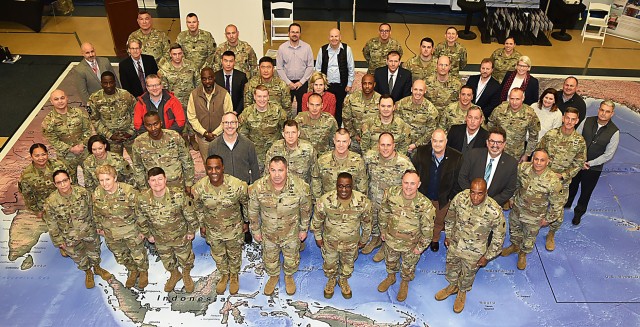
ROCK ISLAND ARSENAL, Ill. — Every organization needs a central, go-to place to get the right information, or where someone can point them in the right direction. Some may think that would be the command group, but who does the command group call when they want the answers?
G3/5/7 (Operations and Training) is that place at U.S. Army Sustainment Command. ASC is the logistics arm for the U.S. Army Materiel Command, the global supply chain manager and lead materiel integrator. ASC G3/5/7 is the nervous system that makes ASC operate, providing Soldiers ammunition, equipment, food and facilities across the globe.
The G simply represents, for Army commands, a section of an organization commanded by a general officer. The numbers — sometimes separated into separate directorates based on the needs of the commander — represent the standardized nomenclature used throughout the military to represent directorates.
So that means combining 3/5/7 makes a directorate powerhouse that becomes the synchronization and integration point for ASC. They are the touchpoint for training, plans, operations and future operations.
This aligns them with AMC, its sister commands under AMC and subordinate units around the globe.
“We're integrated in the entire process of operations,” said Col. Pete Nienhaus, deputy chief of staff G3/5/7. “We manage everything from installation, operations, supply, maintenance to our APS (Army Prepositioned Stock) across the globe for contingency operations or training support.”
That makes G3/5/7 an integral part of all things ASC. From a basic task of having the appropriate number of chairs at a ceremony to equipping deploying troops for hostile environments , they are involved in every aspect of ASC accomplishing its mission.
And that management goes farther than movement, maintenance and storage. The Army runs on procedure and doctrine, which is where ASC and G3/5/7 shine.
“Our folks spend a lot of time working the coordination and being the staff for that conduit function — they are heavily involved in doctrine update,” said Tom Kenyon, assistant deputy chief of staff G3/5/7. “G3 is running that (operational planning team) and driving the staff through the steps.
“But the subject matter experts are truly the staff, and we pull those SMEs together for interface or integration, to conduct a mission and execute.”
That makes the ASC team the driving force behind getting the appropriate key players together to make the most informed decisions when solidifying doctrinal changes.
But seeking subject matter experts from other places doesn’t diminish the team in G3/5/7. They have a lot of experience in their directorate.
“We're about 65 individuals strong, comprised of civilians and military personnel with a wide range of expertise — a lot of knowledge,” said Nienhaus. “We have individuals with 10 years of experience and even two individuals with 40 years of experience. We bring a lot to the table when operations are coming in.”
Both Nienhaus and Kenyon lauded the experience of their staff.
“A lot of good people, a lot of very smart people that you surround yourself with,” said Kenyon. “One of the things that we have here is really a great blend between the Civilian workforce and the military.”
He also said the Civilian workforce provides continuity and stability while the military can bring fresh perspectives from other echelons of commands. This helps when processing orders — one of the bread-and-butter missions of G3/5/7.
Those orders come in from AMC and higher. These orders specify tasks and requirements, but G3/5/7 builds the responsibility and output required by ASC and the brigades.
“Our real job back here is customer service, with our customer being the command,” said Tim Meidinger, G3 Command Operations and Information Center chief.
Meidinger said his team processes around 60,000 emails each year consisting of orders, taskers and other requests.
These come through a task management system that is used Army-wide meaning that users on both ends of an order or tasker are familiar with the format and process.
Here is what happens when an order comes down from AMC, ASC’s higher headquarters.
“We’ll take a look at the order and make a determination of who needs to see it -- what the tasks are to ASC,” said Meidinger. “Those orders are then pushed out to the sections necessary to confirm receipt — that they understand the tasker and that they are going to comply with the tasker.”
G3/5/7 would then work with each of these sections to make sure timelines can be achieved and that they have everything necessary to complete the task.
“The COIC is basically the central location for all information coming into the command and also leaving the command,” said Meidinger. “We serve as a filter, to make sure information doesn’t just fly all over the place — we try to bring some control and some coordinated response to some of the taskers and orders we get.”
As is apparent, G3/5/7 has their fingers in a little bit of everything in the command.
“The overarching part goes back to the original with the synchronization and integration to get a total end product,” said Kenyon, “but it takes the rest of the staff and their expertise to bring the whole game plan together to benefit and support whatever the end state is.”

Social Sharing